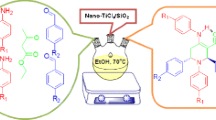Abstract
The reaction of Ta(NMe2)5 with excess iPrNH2 (20-25 equivalents) at room temperature yields the pentanuclear tantalum cluster Ta5(μ5-N)(μ3-NiPr)2(μ2-NiPr)6(η1-NiPr)4(η1-NHiPr)2 (1) in 17 % yield. 1 has been characterized by 1H NMR spectroscopy and X-ray diffraction analysis. 1·pentane crystallizes in the monoclinic space group P2(1)/c, a = 21.669(2) Å, b = 12.6412(9) Å, c = 43.451(3) Å, β = 91.535(1)°, V = 11898(2) Å3, Z = 4, and dcalc = 1.961 Mg/m3; R = 0.0723, R w = 0.1599 for 24154 reflections with I > 2σ(I). The structural highlights in 1 include a hinged-butterfly arrangement of tantalum atoms that encapsulate an interstitial μ5-nitride moiety, three different types of imido groups, and one set of amido ligands. Compound 1 represents the first structurally characterized paradigm of a polynuclear cluster whose coordination sphere contains five different types of nitrogen ligands.
Graphical Abstract
The homoleptic amido compound Ta(NMe2)5 reacts with a large excess of iPrNH2 at room temperature to furnish the pentanuclear tantalum cluster Ta5(μ5-N)(μ3-NiPr)2(μ2-NiPr)6(η1-NiPr)4(η1-NHiPr)2 (1) in 17 % yield. The presence of an interstitial nitride moiety, three different types of imido groups, and one set of amido ligands in cluster 1 has been established by X-ray crystallography.


Similar content being viewed by others
References
Leskelä M, Ritala M (2003) Angew Chem Int Ed 42:5548
Niinistö J, Kukli K, Heikkilä M, Ritala M, Leskelä M (2009) Adv Eng Mater 11:223
Taeseung K, Zaera F (2011) J Phys Chem C 115:8240
Rayner GB Jr, George SM (2009) J Vac Sci Technol A 27:716
Huang SH, Pilvi T, Wang X, Leskelä M, Richmond MG (2010) Polyhedron 29:1754
Huang SH, Wang X, Nesterov V, Hrovat DA, Hall MB, Richmond MG (2011) Organometallics 30:2832
Suh S, Hoffman DM (1996) Inorg Chem 35:5015
Lehn JSM, van der Heide P, Wang Y, Suh S, Hoffman DM (2004) J Mater Chem 14:3239
Krinsky JL, Anderson LL, Arnold J, Bergman RG (2008) Inorg Chem 1053
Riley PN, Parker JR, Fanwick PE, Rothwell IP (1999) Organometallics 18:3579
Shriver DF (1969) The manipulation of air-sensitive compounds. McGraw-Hill, New York
APEX2 Version 2.14, Bruker advanced analytical X-ray systems, Inc. Copyright 2007, Madison
SHELXTL Version 6.14, Bruker advanced analytical X-ray systems, Inc. Copyright 2003, Madison
Spek AL (2006) PLATON: A multipurpose crystallographic tool, Utrecht University, Utrecht
Banaszak Holl MM, Wolczanski PT (1992) J Am Chem Soc 114:3854
Dyson PJ, McIndoe AS (2009) Transition metal carbonyl cluster chemistry. Overseas Publishers Association, Amsterdam
Harris S, Blohm ML, Gladfelter WL (1989) Inorg Chem 28:2290
Albright TA, Burdett JK, Whangbo MH (1985) Orbital interactions in chemistry. Wiley, New York
Lappert M, Protchenko A, Power P, Seeber A (2009) Metal amide chemistry. Chap. 6. Wiley, New York
Burland MC, Meyer TY, Geib SJ (2003) Acta Crystallogr C 59:m46
Merkoulov A, Schmidt S, Harms K, Sundermeyer J (2005) Z Anorg Allg Chem 631:1810
Wade K (2009) In: Johnson BFG (ed) Transition metal clusters, Chap. 3. Wiley, New York
Teo BK, Longoni G, Chung FRK (1984) Inorg Chem 23:1251
Conole G, McPartlin M, Powell HR, Dutton T, Johnson BFG, Lewis J (1989) J Organomet Chem 379:C1
Braga D, Grepioni F, Sabatino P, Dyson PJ, Johnson BFG, Lewis J, Bailey PJ, Raithby PR, Stalke D (1993) Dalton Trans 985
Blaje AJ, Dyson PJ, Johnson BFG, Braga D, Byrne JJ, Grepioni F (1995) Polyhedron 14:2697
Freeman G, Ingham SL, Johnson BFG, McPartlin M, Scowen IJ (1997) J Chem Soc, Dalton Trans 2705
Acknowledgments
Financial support from the Robert A. Welch Foundation (Grant B-1093-MGR) and Lam Semiconductor is much appreciated. NSF support of the UNT NMR facility through grant CHE-0840518 is acknowledged.
Author information
Authors and Affiliations
Corresponding author
Rights and permissions
About this article
Cite this article
Huang, SH., Nesterov, V.N. & Richmond, M.G. Synthesis and Structural Characterization of the Pentanuclear Tantalum Cluster Ta5(μ5-N)(μ3-NiPr)2(μ2-NiPr)6(η1-NiPr)4(η1-NHiPr)2 from the Reaction of Ta(NMe2)5 and iPrNH2: Unprecedented Formation of a Hinged-Butterfly Cluster Containing an Interstitial Nitride, Imido Groups, and Amido Groups. J Chem Crystallogr 42, 916–922 (2012). https://doi.org/10.1007/s10870-012-0336-3
Received:
Accepted:
Published:
Issue Date:
DOI: https://doi.org/10.1007/s10870-012-0336-3




